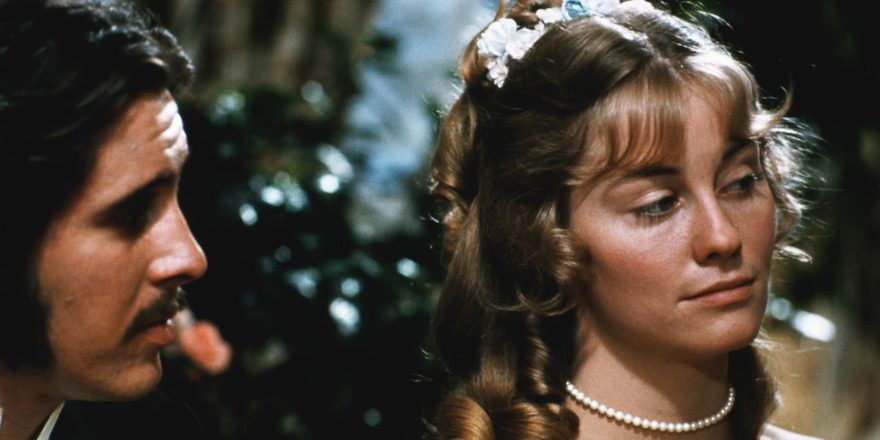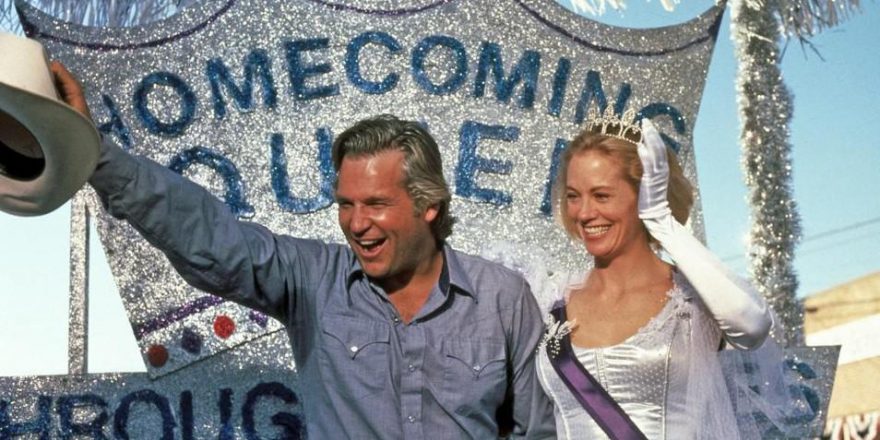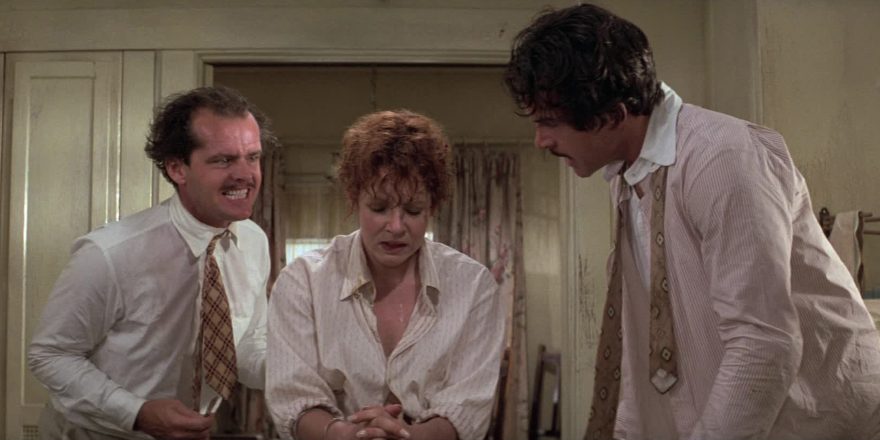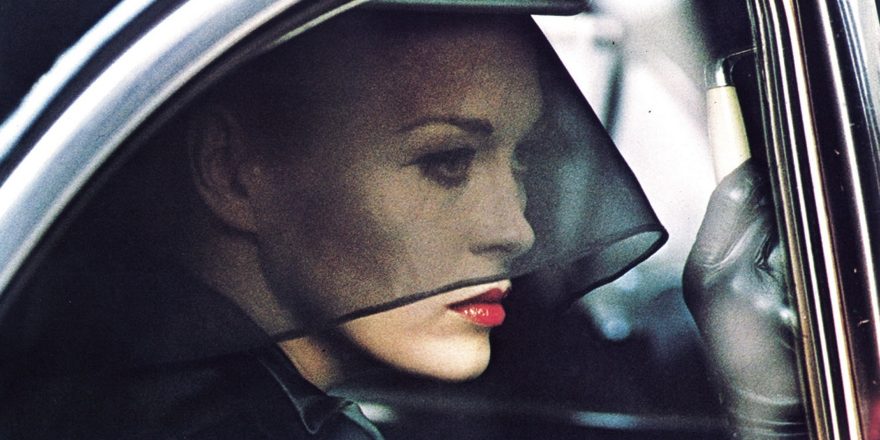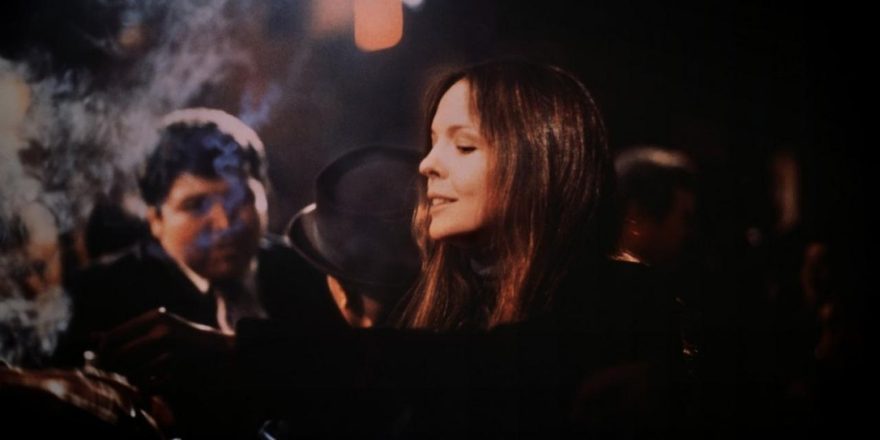Daisy Miller, the 1974 Peter Bogdanovich film, based on the 1878 Henry James novella of the same name, was not received well by most critics upon its release, nor, scandalously, has it been subsequently very much appreciated or re-evaluated. After repeated viewings over the past decade, it has improbably become one of my favorite films of the seventies (which is saying a lot, considering my obsession with movies of that era), and indeed I regard it as the director’s masterpiece.
Bogdanovich shot to fame with his 1971 film The Last Picture Show, co-written with Larry McMurtry, based on his novel, casting 21-year-old model Cybill Shepherd in a key role. They fell in love on the picture, and after directing two more successful films – What’s Up, Doc?, in 1972, starring Barbra Streisand and Ryan O’Neal, and Paper Moon, in 1973, also starring O’Neal, and his daughter, Tatum, the role for which she won a Best Supporting Actress Oscar – Bogdanovich finally found a vehicle for Shepherd, a part she desperately wanted to play, despite the fact that it would be a period costume drama made in a period of anything but.
Originally, Bogdanovich intended to star in the film with Shepherd and have it be directed by his friend and mentor Orson Welles, who lived at his house in Los Angeles for several years in the early seventies while going through financial difficulties. (Bogdanovich cites Citizen Kane as the film that most inspired him to become a director.) Welles convinced the younger filmmaker that he must direct the film himself, so the part of Winterbourne, Daisy Miller’s ambivalent and troubled admirer, went to actor Barry Brown, who had made a splash in Robert Benton’s Western Bad Company two years earlier. After the seriously negligent reviews of Daisy Miller – which, according to Bogdanovich, were largely due to the envy the public and critics alike felt for its beautiful and successful director-star couple (Bogdanovich has always had nothing if not a healthy ego) – one could argue that the director’s career henceforth took a trajectory not unsimilar to Welles’, only occasionally making a noteworthy film (Saint Jack in 1979; Mask in 1985), and never fulfilling the promise of his early masterpieces.
I rarely recommend that people listen to director’s commentaries on DVDs (as D.H. Lawrence warned, never trust the teller, trust the tale), but I would make an exception for Daisy Miller. Aside from the director’s own impressive erudition on the subject of cinema, the deeply personal significance of the film for him, particularly in retrospect, is not just a little heartbreaking. Not only is the film remarkably melancholy in and of itself, but its foreshadowing of Bogdanovich’s subsequent tragic relationship with Dorothy Stratten, the Playboy Playmate of the Year that he cast and fell in love with on the set of his 1981 film They All Laughed, makes it even more so. Stratten was 20, just a bit older than the character Daisy Miller upon her death, when she was brutally murdered with a shotgun by her former lover and manager, Paul Snider, a horrific story that was told two years later by Bob Fosse in his film Star 80. In the commentary, Bogdanovich reflects upon how, much like Winterbourne, perhaps if only he had done things slightly differently in his relationship, or had understood what was really going on inside the head of his paramour, she might have been spared her cruel fate. Indeed, Bogdanovich regards Daisy Miller as an eerie kind of premonition of Stratten’s death, made even more mysterious by his extreme difficulty in shooting the final scene of the film, Daisy’s funeral, the filming of which had to be postponed several days due to his overwhelming sadness and discomfort about it.
But the Stratten story is not the only one that haunts the film. In his commentary, the director points out that two of Daisy Miller‘s principle crew members died relatively young – Ferdinando Scarfiotti, the famous Visconti production designer, who died at 53, and Alberto Spagnoli, the director of photography, who died at 49 – as did two of its stars, Duilio Del Prete, who plays Daisy’s Italian suitor, Mr. Giovanelli, who died at 59, and, most disturbingly, the film’s co-star, Barry Brown, who died of a self-inflicted gunshot wound in 1978, becoming an unfortunate member of the “27 Club.” It’s Brown’s tragic life in particular, with which the character of Winterbourne is so thoroughly imbued, that retroactively turns the film for me into such a sombre and bitterly sad viewing experience. (I can’t go into details here, but for Brown’s backstory I highly recommend his brother James’ memoir The Los Angeles Diaries, which tells the tragic tale of his dysfunctional family, including the subsequent suicide of his sister, Marilyn, also an actor, in 1998, by jumping off a freeway overpass in L.A.)
Ultimately, Daisy is a protofeminist character – American vigour and frank sexuality embodied in a headstrong, independent young woman.In the commentary, Bogdanovich speaks of Brown’s “morose and macabre attitude in life”; his habit of reading the obituaries every day on set, revealing his obsession with the details of the deaths of Hollywood bit players and minor stars, is incorporated into the film in an early scene in which Winterbourne does the same. I’ve heard anecdotally that Brown was bisexual, and there were rumors that when he shot himself in the bar/restaurant the Frog Pond on Hyperion in Silver Lake, it was not only owing to his alcohol addiction, but also over a gay affair gone wrong. I confess to having the same obsession as Brown for the details of such sordidly sad Hollywood deaths, which is the only reason I mention it.
Now to the film itself: what makes Bogdanovich’s adaptation of the Henry James novella so extraordinary is both its faithfulness to the original text, and the cleverness of its divergences, which mostly entail adapting descriptive passages to dialogue, and inventing new dialogue. But the director also isn’t afraid to come up with a few narrative inventions of his own. The opening shot, a pan down to a custodian mopping the floor of the Trois Couronnes hotel in Vevey, Switzerland, marks his first of many references to the working class that are woven into the film (even more prominently than James does in the novella), its boredom and naturalness set in stark contrast to the phony upper class snobs of the story. The film starts not with Winterbourne, as in the novella, but with Randolph, Daisy’s truculent little brother. The Miller family is introduced by a track into three pairs of shoes in front of their hotel door – a neat bit of synecdoche – as Randolph exits the room. He precociously mixes up all the shoes in front of the hotel doors on his floor before stealing a walking stick from the lobby and heading to the garden, poking belligerently at women’s dresses. Buck-toothed Randolph, with his big red bow-tie, knickers and oversized newsboy cap, is probably one of the most unsympathetic child characters in cinema, and one of the most vivid. The dialogue Bogdanovich creates for him is pure genius. “You live in Europe? Why? What happened?” he asks Winterbourne in his nasally, wiseacre voice, a man in a child’s body. When Daisy appears like a vision in the garden where Winterbourne is having breakfast, he asks Randolph if he knows her. “I don’t know her. She’s my sister,” he deadpans. (Incidentally, Randolph is played by James McMurtry, Larry McMurtry’s son, who named him after Henry James!) The dialogue that Frederic Raphael invents for the film is completely consistent with James’, but considerably funnier, adding humor to counterbalance the tragedy.
The first shot of Winterbourne and Daisy together, a single take covering 15 pages of dialogue, is remarkably complex, but so well executed that it seems totally natural. (A later scene, in Mrs. Walker’s drawing room, covers 20 pages of dialogue in two single takes, including complicated deep-focus mirror shots and astounding camera choreography.) The camera follows the couple effortlessly, framing and reframing them for about six minutes. Given the sheer amount of dialogue Shepherd has to deliver in one take, her performance becomes more impressive each time I watch the film. On first viewing, her acting seemed fake, almost amateurish, but now it seems to me quite prodigious, and perfect for the innocent straightforwardness and coquettishness of the young American girl, at once insouciant and come-hither. Her breathless, run-on sentences leave her fellow American expat Winterbourne flustered and frustrated as she continuously ignores his witticisms and bon mots. But it’s Barry Brown’s performance that always gets to me. With his heavy-lidded brown eyes and full lips, his peaky pallor and lithe frame, his mutton chops and dandy style – true to the period, but strangely consistent with the seventies – he embodies perfectly the louche elegance and tragic aloofness of Winterbourne, the nouveau European stiff that Daisy finds so hard to warm up.
In the following scene, Winterbourne has tea with his aunt, Mrs. Costello, ingeniously played by Mildred Natwick, in a swimming pool, the silver tea services set on floating trays, another invention by the screenwriter that opens up James’ insular chamber piece. She makes clear to Winterbourne her disdain for the vulgar Millers: “They’re terribly common, my dear Frederick. They’re the sort of Americans one does one’s duty by just ignoring.” When he tries to defend Daisy, she cuts him cold. “She’s a young lady who has an intimacy with her Mama’s courier!” she says, aghast. Daisy Miller is, after all, about the intransigent moral superiority and social propriety of the European upper class of the late 19th century, and its disdain for American brashness and lack of “society,” not to mention its moral turpitude. Mrs. Costello appears throughout the film to diminish Daisy to her lovestruck nephew. Later she offers, “I’m not sure she’s capable of any thought at all. I certainly see no evidence of it. She romps on from day to day, from hour to hour, as if a lady from the Golden Age. I can think of nothing more vulgar.” Of Daisy’s eventual Italian love-interest in Rome, who doesn’t measure up to the standards of high society, Winterbourne muses, “If only he were a marquess, or even a count,” to which his aunt replies, “Or, indeed, anyone at all!”
Ultimately, Daisy is a protofeminist character – American vigour and frank sexuality embodied in a headstrong, independent young woman. When Daisy, symbolizing spring, and her chilly pursuer, Winterbourne, his name invoking the coldest season, visit the Castle of Chillon in Vevey, she runs through the storied castle like she rushes through sentences, unable to wait to get to the next thought, the next room. She teases her cautious suitor relentlessly, challenging him at every turn, or stopping her gay prattle to give him a look of pure carnality. Bogdanovich strategically uses a number of close-ups of Shepherd throughout the film, looking either flagrantly sexual or deeply hurt, to his utmost advantage. Winterbourne crushes her when he says he has to leave Vevey the next day, implying he will have a rendezvous with a woman of means in Geneva. The shot of the castle in the rear-view window of the carriage as they ride wordlessly back to the hotel is heartbreaking.
Daisy’s “recklessness,” as the European snobs are wont to call it, leads to her ultimate demise in Rome when she takes up with the hapless Mr. Giovanelli, a rake with social ambitions who is nonetheless as guileless and innocent as the young American girl he is pursuing. After ignoring the admonitions of Mrs. Walker (played brilliantly by Eileen Brennan), a wealthy American widow living in Rome, to “not prowl off to the Pincio at this hour to meet a beautiful Italian” upon leaving her party, Daisy takes Winterbourne’s arm and has him accompany her to the fabled gardens to seek her beau. When they stop to watch a Punch and Judy show (another clever divergence from the novella), Winterbourne looks at Daisy with a profound sadness, only brightening slightly when she laughs and gives him a deeply flirtatious look. It’s another understated moment in a film all about the subtleties of looks and exchanges of glances. Daisy’s protofeminism becomes more pronounced when she finally spots Mr. Giovanelli as he stares at all the beautiful women who pass by. “Did you ever see anything so cool?” she asks Winterbourne. (Although at the time critics lambasted the film for Shepherd’s “anachronistic” performance, supposedly reinforced by her use of the word “cool,” it is, in fact, the same word James uses in the novella.) When Winterbourne says he intends to stay with her despite the presence of the Italian, Daisy objects, “I don’t like the way you say that. It’s too imperious … I’ve never allowed a gentleman to dictate to me or interfere with anything I do.” (Indeed, the tagline for the film was “She did as she pleased.”) The film plays out with Daisy ruthlessly torturing and teasing Winterbourne about whether or not she’s engaged to Mr. Giovanelli, without any malicious intent whatsoever, and the confused Winterbourne being totally oblivious to the fact that she’s actually fallen in love with him. When he invites himself over to her rooms and hears her sing “Maggie” accompanied by Mr. Giovanelli on the piano, Winterbourne’s eyes become black marbles of infinite sadness as he is almost brought to tears.
The end of Daisy Miller is devastatingly unhappy, brilliantly realized by Bogdanovich. Daisy’s recklessness has led her to be exposed to malaria while visiting the Colosseum with Mr. Giovanelli at night, where Winterbourne confronts her and castigates her for being so careless. He is fed up with her intimacy with Mr. Giovanelli, and tells her, “I believe it makes little difference whether you are engaged or not.” A final close-up of Daisy shows how deeply hurt she is, and as she rides away in her carriage, she yells back to Winterbourne, “I don’t care if I have the Roman fever or not!” Several weeks later, she dies of malaria. In the scene in which Winterbourne discovers the grim news, the camera stays behind a flowered (daisied) curtain outside the hotel, and captures his reaction in an obscured long shot, a remarkably restrained choice of coverage that attests to the director’s subtlety. The film ends with a tracking shot as the camera pulls back from Winterbourne at Daisy’s grave, surrounded by daisies, accompanied by voice-over dialogue between him and his aunt. (The novella ends with an actual scene between the two.) “It’s my conscience, you see,” he says to her, “I’m afraid I did her an injustice.” When she asks how, he says, “She sent me a message before she died. I didn’t understand it at the time, but I’ve understood it since. I think she would have … appreciated my esteem.” “Is that some modest way of saying she would have reciprocated your affection had you shown it?” she asks. “You were right, you know, that remark you made last summer,” he replies. “I was booked to make a mistake. I’ve lived too long in foreign parts.” As he realizes that it was his inability to understand Daisy’s “inscrutable combination of audacity and innocence,” as James put it, that contributed to her death, a fire of leaves in the background creates a scrim of smoke as he is left standing forlornly by the grave and the picture fades to white, “Maggie” playing in a minor key over the credits. It’s one of the most profoundly sad endings to any film, and one that Bogdanovich would later truly understand only too well.


